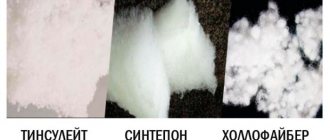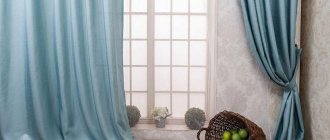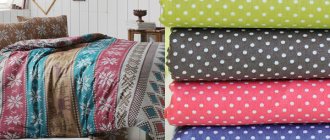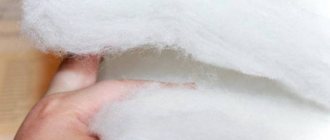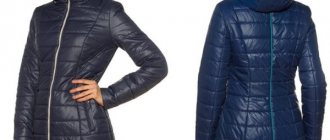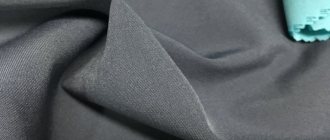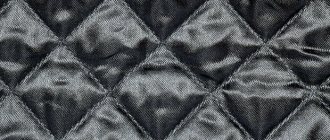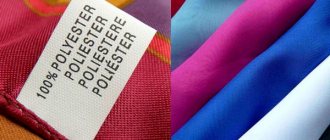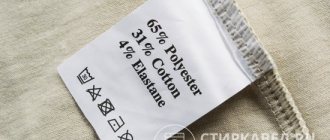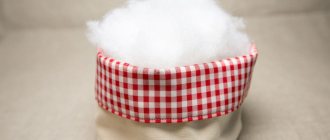Polyester is a synthetic textile product made from polyester fiber. This can be a thin fabric from which summer and sportswear is sewn, or a non-woven fabric used as insulation in the manufacture of jackets and coats. Products made from this durable and inexpensive material account for more than half of the volume of the modern textile market. High-quality polyester is produced using the latest equipment and is quite capable of competing with natural materials. Clothing with polyester filling is relevant both in autumn bad weather and in winter cold.
History and production now
Polyester was invented in the 30s of the 20th century in Great Britain. At that time, the technology for producing nonwoven materials was invented. Soon it began to be used in clothing as insulation. In Russia, fiber began to be produced by the end of the 40s, and filler - in the 60s.
Polyester - what kind of filler? Polyester fibers are made from petroleum products: terephthalic acid and ethylene glycol. A few decades ago, many mechanical and chemical processing steps were required. How PE filler is made now:
- preparation of raw materials - cleaning and loosening;
- formation of a fibrous base;
- joining fibers by mechanical, physico-chemical or temperature effects;
- finishing of finished insulation.
It is necessary to cleanse from impurities and by-products. They are harmful to human health.
Description of material, cost, composition
Now a little more about polyester, what kind of material it is, is it warm or not and in what form is it produced. To put it in simple words, it is an accumulation of polyethylene fibers, solid or hollow, loosely fastened together. Due to this looseness, many cavities filled with air are formed in the thickness of the insulation. The number of cavities, in turn, depends on the thickness of the insulation and the diameter of the fibers from which it consists. And the more air there is in the thickness of the layer, the more heat it will retain.
Insulation materials made from polyester can be divided into two types:
- Volumetric fillers, the number of air cavities in which increases due to the thickness of the material itself. The most budget option is padding polyester. Its initial cost is less than 200 rubles. per linear meter. More expensive, but better - Thinsulate, from 450 rubles. per linear meter.
- Thin-layer materials, where the small thickness of the filler is compensated by the small thickness of the fibers, which provides a sufficient number of air cavities in the layer. The cheapest variety is polyester fleece. It will cost you from 250 rubles. for 1 meter. There is also a more advanced version, depending on the manufacturer, such a canvas can cost from 350 (Korean) to 2500 rubles (original, produced by Polartec® LLC).
The composition of the fillers - insulation in question - is 100% polyester, or the same, but with a small inclusion of other fibers.
Where is it used?
Polyester filler is used in many areas:
- insulation of houses;
- car seat filling;
- insulation of sports items, outerwear;
- making quilted lining;
- the inside of pillows, blankets;
- filling soft toys, sides of cribs;
- production of thermal underwear, sleeping bags;
- making the insides of autumn and winter boots.
Various materials are made from polyester fibers. They are becoming more and more popular.
Lining fabric
Polyester lining material is used for the following products:
- trousers, dresses, skirts, suits;
- jackets, jackets, coats;
- winter jackets and overalls.
The polyester lining does not wrinkle or stretch, and remains in its original form for a long time. It does not allow moisture and heat to pass through. Winter polyester lining fabrics are supplemented with thermal protection.
Read about: fibertek insulation
Reviews
Sergey. When I first bought a jacket with Thinsulate as a filler, at first I couldn’t understand what was going on. I’ll put it on, go out, and at first it’s hot, and then I’m all wet and freezing. And then I started reading reviews about polyester insulation in jackets and among them I found a problem similar to mine: the polyester filling itself is very warm, which is why it sweated, but the fabric of the jacket is a membrane that should remove moisture from the body. But for all this to work, what is worn underneath must be synthetic. And I wore cotton turtlenecks and T-shirts, which themselves get wet and don’t release moisture. In general, everything is fine now, I wear the jacket with pleasure.
Natalia. I would like to add a review about a polyester down jacket. My husband has a work pea coat with this kind of insulation. I don’t know what specific type, it’s something very voluminous, the jacket is very thick. But at the same time it weighs relatively little and is very warm. I can’t say anything about how it handles washing, because I’ve never washed it before. It was inexpensive, so even if it fails in one season, it’s no big deal.
Irina. Of course, I like down jackets, but polyester filling is more practical. There is much less fuss with washing and drying. Is it warm - yes, I am satisfied with the insulation in this board. Throw the fluff balls into the machine, and buy a special product, and then shake out any more lumps if you get any. A jacket with polyester as a filler can simply be washed on a delicate cycle. It seems like it should be dried flat out, but I'm using it on hangers, because the insulation is not thick and is well quilted.
Read positive reviews about polyester insulation in another article.
Positive and negative qualities
Positive characteristics of the material:
- lightweight, retains heat at low temperatures;
- shape-stable, durable, wear-resistant;
- there are inexpensive types;
- even expensive or medium-priced items are cheaper than natural down ones;
- easy care, resistant to stains;
- does not deteriorate under the influence of inorganic acids and alkalis;
- not affected by insects, microorganisms, mold;
- universal – suitable for winter and demi-season items;
- many options retain heat better than natural down.
Disadvantages of polyester filling:
- accumulates static electricity (using an antistatic agent will solve the problem);
- the canvas is slightly stiff;
- cheap options cause allergies;
- the unquilted cheap types fall into clumps after five or six washes and stop heating;
- if you accidentally spill solvent, gasoline or acetone, the fibers will dissolve;
- most polyester fillers quickly absorb water and reduce thermal protection;
- Inexpensive materials do not allow air to pass through well.
To reduce the number of shortcomings and enjoy the positive aspects, when choosing a jacket you should carefully study the type of filling. If you can spend more, don't save.
Types of insulation and their temperature characteristics
Modern fillings for winter jackets are made in most cases from polyester fibers. This choice is easily explained: the cost of synthetics is lower, it does not harbor microorganisms, for example, dust mites, it is easier to care for, and in terms of protection from the cold it is in no way inferior to natural fillers. There are several types of insulation for jackets.
Clothing with polyester filling is relevant both in autumn bad weather and in winter cold.
Holofiber
Nonwoven material consisting of hollow fibers. The name comes from the English hollow - empty, fiber - fiber. Externally, the fibers look like springs. They are located in a chaotic order: vertically and horizontally. The internal cavities are sealed on all sides. Air chambers are formed, which allow one to retain body heat and warm a person in the cold.
Holofiber is one of the most popular materials today.
The density of holofiber can be different - from 60 g/m2 to 400 g/m2. Spiral-shaped fibers intertwine with each other and give the material springiness. Due to this, it easily restores its shape after compression
Pros:
- retains heat well;
- does not accumulate dust;
- does not provoke allergies;
- does not wear out for a long time;
- non-toxic, environmentally friendly;
- suitable for home washing;
- washes without problems and dries quickly;
- elastic and easily restores shape;
- does not accumulate static electricity;
- does not absorb odors.
The material attracts everyone with its practicality and low price.
Minuses:
- More expensive than analogues, for example, padding polyester.
- Does not absorb moisture well.
Sintepon
The most famous type of insulation. It is a fabric made of polyester fibers. They are fastened together in different ways: with adhesive, needle-punched technology or using heat treatment. The main characteristics of synthetic winterizer are light weight, lack of toxicity, low cost, low melting point. Some types of padding polyester contain natural ingredients such as wool or cotton.
Sintepon is a light, voluminous, elastic non-woven material in which a canvas made of synthetic fibers is bonded with adhesive or thermal methods.
Pros:
- high-quality thermal insulation;
- rapid restoration of shape after compression;
- affordable price;
- hypoallergenic;
- a large selection of types of padding polyester for different purposes.
Minuses:
- padding polyester made using the glue method using low-quality glue causes allergies;
- Low breathability can cause discomfort due to the fact that a person begins to sweat.
Sintepon is a fairly common material and has a wide range of applications.
Another significant drawback is that synthetic winterizer is not suitable for cold winters; the maximum recommended outdoor air temperature for synthetic winterizer is -10°C, in rare cases -20-25°C.
Isosoft
Isosoft is a modern product, a leader among European fillers. It differs from previous analogues in its lighter weight and improved thermal insulation properties. Clothing with isosoft insulation is almost weightless, but at the same time it warms well in cold weather. Isosoft filling is 4 times warmer than synthetic padding.
Isosoft is a modern filler for outerwear and sportswear.
The fibers are twisted so tightly that they form a ball shape. Thanks to this feature, the material can be easily distinguished from other insulation materials.
Isosoft is used for various purposes. Today it is often used to fill blankets, pillows, and mattresses. It can be used to insulate jackets, down jackets, sleeping bags, sportswear for children and adults, as well as uniforms.
Pros:
- excellent heat retention properties;
- good air conductivity;
- minimum weight;
- soft and elastic texture;
- small thickness;
- good resistance to washing;
- rapid restoration of shape after compression.
An innovative product that differs from its predecessors in its lightness and high thermal insulation ability.
Minuses:
- High price. High-quality material is purchased in Belgium. Therefore, the price of such isosoft is more expensive than the cost of other insulation materials.
Thinsulate
Thinsulate is a NASA order for industrial companies. Initially, the material was produced for astronauts and polar explorers. The main requirements that were put forward for it were light weight, good water-repellent properties, and heat retention even in the most extreme conditions.
In properly selected outerwear based on Thinsulate, even the most severe frosts are not scary.
This type of insulation is often called artificial swan down. It is a highly siliconized fabric, which consists of fibers twisted in a spiral. They are 60 times thinner than a human hair. The average diameter is about 5 microns. The outer side of the fibers is treated with silicone. In terms of thermal insulation properties, Thinsulate is 1.5 times superior to natural swan down.
Pros:
- environmental friendliness and health safety;
- soft and weightless texture;
- does not absorb the smell of sweat and other foreign odors;
- the warmest and lightest of all insulation materials;
- does not shrink when washed;
- dries quickly;
- does not cause allergies;
- does not form lumps and does not deform after washing in the machine;
- durable and wear-resistant.
Thinsulate is considered the safest and warmest insulation of the new generation.
Minuses:
- accumulates static;
- in some cases may lead to overheating.
What type of polyester insulation is used in jackets?
Many people associate synthetic padding with polyester filling. This name is not registered as a trademark, so various manufacturers produce it. There are many other types of polyester insulation with improved characteristics. Their names are registered and patented. These are holofiber, Thinsulate, Isosoft, Fellex and others.
Sintepon
There are two types:
- Old - from 2 or more layers of threads in one direction. Suitable for demi-season clothing at temperatures down to -5 degrees. The fibers are poorly connected, the product will wear out quickly. The filler rolls down and works its way out through the upper material.
- In the new padding polyester, the fibers are thermally connected. The material has a layer of air. Weighs less than the previous version and is more durable. Retains heat well.
After washing, even the new version loses half its thickness. Frequent washing reduces the elasticity and thermal conductivity of the material. Sintepon cannot be washed in a machine. Types of density - 100, 150, 200, 300 g/sq. m. Suitable for use at temperatures down to -25 degrees.
The structure of the threads is twisted, ensuring durability. Does not lose shape, dries quickly, weighs little. Does not allow air or water to pass through.
Sintepooh
Made to look like natural fluff. For this purpose, polyester fibers are glued together using a special method. Wear-resistant, does not wrinkle and dries quickly. Is synthetic fluff warm or not? For winter with a temperature of -25 degrees, an option with a density of 250 g/m is suitable. sq. At a temperature of 5 degrees, 60 g/m is sufficient. sq. There are two varieties, the first is homogeneous and more elastic.
Holofiber
The two outer parts of the web contain balls of fibers inside; they can be located perpendicular to the main parts. The properties of the material allow excess liquid to evaporate freely, while retaining heat. A person does not freeze, does not sweat.
Holofiber is approved for use in children's clothing. It does not cause allergies and is suitable for everyone. Its properties are similar to bird fluff. It can be easily washed in a machine on a delicate program. Density 70-300 g/sq.m. m. Recommended for weather from +5 to -30 degrees.
Isosoft
The polyester insulation in jackets from a Belgian company is in the form of balls between two fabrics. Easy to wash, dries quickly. Does not deform. Thin, the jacket does not look puffy. Sometimes 80-250 gr.
Hollophan
It consists of two canvases filled with material twisted in a spiral. Lightweight material that does not absorb water. A down jacket with such filling will always keep you warm and cozy.
These two materials are variants of holofiber, which are produced by different companies.
Thinsulate
What it is? Artificial down, the characteristics are no worse than natural. It was invented for space flights. Now the material is used as filler in overalls and winter suits for sailors, oil workers, and sleeping bags for climbers.
Depending on the density of the filler, products made from Thinsulate are suitable for temperatures from -30 to -60 degrees. It is used to make winter clothes for children.
The material is expensive. Its fibers are very thin, the products are light. Things allow air to pass through well. Very warm, keep the right temperature. It happens from 100 to 480 gr.
Fellex
Fellex polyester comes in different shapes: balls, spirals, solid layers. The layers of fibers are fused together at high temperatures. Density options: 120, 220, 250, 300 g.
The material is lighter than padding polyester, but warmer. The absence of an adhesive component prevents the insulation from rolling and deforming. It costs less than natural fillers and has no worse characteristics.
Fellex does not require special care and is suitable for children and adults. At low temperatures it warms well, the lining retains heat.
What else do you have
Other PE fillers:
- Thermofinn is made from 85% crimped fibers, the remaining 15% solid bicomponent. This raw material is placed inside the shell. Density options - 100, 150, 200 g/sq. m. Application temperature from -15 to -55.
- Fleece is a non-woven base with a fine pile. Typically used as a lining. Density 100-600 g/sq.m. m.
- Polartek is a type of fleece with the addition of 2-3 layers of protective coating against water and wind. The density is like regular fleece.
Fleeces are used both as lining and as separate clothing. Used on its own at +10. Polartek is suitable for -20 degrees.
Features of modern polyester
The general name “polyester” covers various materials based on polyester fiber.
Until recently, it was believed that clothing with synthetic insulation was in many ways inferior to products made from natural materials. The consumer's skepticism was well founded. After all, the polyester produced in the past easily wrinkled and caked, causing the product to lose its shape. In addition, the insulation quickly lost its thermal insulation qualities, and after the first wash the item became completely unusable.
The low quality of the material and the inability of the insulation to meet its intended purpose was explained by the structure of the material.
- In the past, polyester fiber was produced in the form of straight threads and placed in the same plane.
- Now polyester consists of fibers twisted into spirals, balls and tubes, inside of which there are air pockets.
Modern polyester is a light and warm material that perfectly copes with the role of insulation for demi-season and winter clothing.
It is impossible to unequivocally answer the question of what temperature a synthetic filler is designed for. After all, the name “100% polyester” can hide Thinsulate, Holofiber, Sintepon, Isosoft and other materials based on polyester fiber. All of them have a certain density and structure, and therefore thermal conductivity.
What is the density of polyester insulation up to what temperature and for what weather?
A jacket with good insulation density will not be cold. The average density of winter clothes is 200-250 g. Material 350 g/sq. m. for what weather: for a very cold winter. At the same time, some types, due to special processing with low density, will warm at very low temperatures.
Is polyester insulation warm? It depends on the type of matter:
- Holofiber retains heat in the same way as natural down. It will keep things warm for winter at temperatures down to -30 degrees. You can safely withstand wind speeds of up to 15 m/s.
- Isosoft is several times warmer than synthetic winterizer. Polyester 300 g/m is suitable for weather -35 degrees. Density 100-150 g for late autumn or early spring, temperature up to -10. The 40-80 g option is suitable for zero temperatures.
- Hollofan with a density of 250 g. suitable for winter clothes. Demi-season ones are made with 150 g/sq.m. m.
- Thinsulate is used for sewing clothes and making shoes. It is the lightest of all types of polyester as clothing insulation. With a density of 480 gsm. m. jacket will warm you in frost -60. With increased humidity, the properties do not change. Thin options are used at +5 degrees.
- Thermofinn perfectly protects against the cold. Protects from cold at -15 with a density of 100 g. 200 g. will be enough for -30. Two layers of insulation from 100 to 150 g. will protect at -45 degrees.
How to choose 100% polyester insulation and for what weather? It depends on the individual characteristics of the organism. Some people wear a fall jacket all winter and don’t get sick. Others won't stay warm until they buy the warmest winter overalls.
Properties, pros and cons
The main criterion that polyester must meet is whether it is warm in winter (or under it). This refers to the level of heat retention under clothing/blanket. Also, these fillers should not create a “greenhouse” effect. And everything else - hydrophobicity, wind protection, abrasion resistance - is secondary, because insulation, as a rule, is always covered with a layer of protective fabric. Of course, unless otherwise stated by the manufacturer.
Advantages of polyester insulation:
- Good heat retention with low filler weight. In some species - even with a small thickness.
- Does not require maintenance.
- After creasing, it quickly returns to its previous shape.
- You can always find inexpensive options.
- Insensitive to alkalis and inorganic acids.
Minuses:
- The cheapest varieties, if they are not quilted, begin to bunch up after a while. Literally 5 washes, and comparing which is warmer, polyester padding or padding polyester is no longer useful.
- Almost all polyester insulation materials, when exposed to water, quickly absorb it, losing their heat-protective properties. The exception is some types of Isosoft, Polartek and Tensulate.
- May become deformed at temperatures above 40 C°.
- Dissolves under the influence of acetone, gasoline, benzene, ethyl acetate and liquids containing these substances.
Please note: a chemical method is often used to bind the fibrous base in cheap insulation materials. If the production technology is violated, the material may contain residual traces of harmful substances. Such fillers can be hazardous to health or simply cause allergic reactions.
Synthetic or natural materials
There can be no question which is better - polyester or synthetic winterizer. It is the same. But padding polyester is considered the cheapest type of polyester and retains heat worse than other material options. This means that you should choose it only when there is no opportunity to buy something better. For example, during warm winters, for demi-season wear or for working outside.
What is better to choose, polyester or down:
- Natural down warms better than many types of polyester. But there are synthetic options with the same characteristics or better. For the northern winter, you should choose Thinsulate.
- Down absorbs any moisture and takes a long time to dry. Due to its naturalness, it is a breeding ground for microbes and insects.
- Synthetic material is easier to care for. A down jacket requires special care. To avoid freezing in it after washing, you will have to beat it with your hands.
Polyester fillers vary in cost. It's easier to find something that fits your budget. Down products cost about the same and are not cheap.
Grams and degrees
The amount of 100% polyester in children's overalls often determines at what minimum temperatures such clothing can be worn. Naturally, everything depends on the size and quality of the insulation, but the weight indicator is sometimes a good guide. For example, for a one-year-old baby, overalls with 80–100 grams of synthetic insulation are acceptable at outdoor temperatures from +5 °C to -5 °C. In order not to be afraid of hypothermia at lower temperatures, you should wear overalls containing 180 or 250–330 grams of insulation.
It is also impossible to determine clear boundaries of the weight indicator due to the individual characteristics of the child (or adult). Some people tolerate frosts easier, others more difficult. In addition, a lot depends on the quantity and quality of clothing worn under the overalls. How to choose the right insulation for certain weather conditions.
Rules of care
Care tips for washing and drying:
- We recommend hand washing or an appropriate washing machine cycle. A delicate program will do.
- The water temperature is not higher than 40 degrees. Spin speed up to 800.
- Be sure to use conditioner. Heavily soiled items are treated with stain remover and soaked before washing. Do not use chemical bleaches.
- Dry in a room with good ventilation. The product should not be hung in direct sunlight. Clothes are hung on hangers away from heating devices.
- Iron in case of urgent need, at minimum temperature, through a piece of dry cloth. Use the steamer with caution if the instructions on the label allow it.
Polyester fibers should not be exposed to high temperatures or boiling. This spoils the structure of the fabric and changes the shape of the item.
Is a jacket with polyester filling warm in winter? Yes, if you choose a quality item and care for it correctly. The product will keep you warm for several more seasons.
Reviews about polyester insulation
Elena, 47 years old, Novosibirsk: as a child she wore a jacket with padding polyester. A huge thing that is uncomfortable to move in and not always warm. Now I buy it with holofiber and feel great.
Anna, 23 years old, Moscow: I love extreme recreation, I bought a winter suit made of Thinsulate a year ago. Nothing has ever been so warm!
Sergey, 31 years old, Vladivostok: I won’t say that holofiber or isosoft are bad, but I prefer to use natural materials as much as possible, like the filling in a down jacket.
Vladimir, 40 years old, Samara: I’m not particularly cold, I usually buy an inexpensive jacket with padding polyester. I'm ok.
© 2021 textiletrend.ru
Which hat to choose
Currently, the main task of hats, berets, hats and caps is to protect the head from unfavorable weather conditions: the scorching sun in the summer (sunstroke has never been useful to anyone) and severe frosts in the winter (meningitis and colds even more so). In addition, hats are stylish accessories that complement the look very favorably.
Knitted hats promise to be the hit of the season. Their design: ornament or embroidery, as well as color can be very diverse. But you should take a very careful look at the material from which the item is made.
How to choose clothes with synthetic insulation?
If you buy clothes from a well-known brand that specializes in the production of outerwear, then there is nothing special to check here; you just need to select the amount (thickness) of insulation that suits your needs. I’ll tell you next time how to navigate the grams of insulation declared by the manufacturer and which indicator is suitable for which weather.
If in front of you is an item of an unknown brand, then first of all pay attention to the uniform distribution of the insulation (without lumps and “bald spots”). Also pay attention to the weight of the clothes - modern insulation is quite light, so if the item is very heavy, then most likely “old” insulation is used.
Advantages and disadvantages of fabric
Like any other fabric, polyester has advantages and disadvantages. The advantages of the material include:
- Low wear and tear.
- Does not stretch or shrink when washed.
- Pleasant to the touch, well suited for sewing clothes.
- Easy to care for, requires normal washing, drying and ironing conditions.
- Does not lose its original brightness for a long time.
- Does not form “pillings” and does not fade when washed.
- Does not create favorable conditions for the development of moths, dust mites, and harmful microorganisms.
Disadvantages of the material:
- High density. The fibers are of chemical origin and tightly woven into fabric. Air permeability tends to zero. Therefore, polyester products are not suitable for summer.
- Rigidity. Its synthetic origin does not allow the material to be as soft as its natural counterparts. To solve this problem, cotton or elastane is sometimes added to the composition.
- Possible allergy. Polyester fiber is not recommended for people with sensitive skin. It is especially undesirable to use the material for those who suffer from psoriasis.
- Electrification. The accumulation of static is a known property of any synthetics. Due to this, products made from polyester fibers are attracted to the skin and collect dust and other particles. An antistatic agent will help remove static electricity.
Thinsulate
Of all the insulation materials made from polyester fiber, Thinsulate is the lightest and warmest. No wonder it is compared to natural swan down. This artificially created material has all the positive qualities of down and at the same time is devoid of its disadvantages.
Thinsulate, consisting of microscopic fibers surrounded by an air shell, is capable of retaining heat and warming the human body at temperatures as low as -60 °C. Moreover, the insulation is not too thick, and the clothes turn out to be light and not bulky.
This material is used to make warm clothes for polar explorers and oil workers, and sew comfortable equipment for climbers. The only drawback of clothes filled with Thinsulate is the high cost.
How to dry and care properly
It is important to check the information on the product care conditions on the label and strictly follow the manufacturer's recommendations. After washing, you need to take the down jacket or jacket out of the machine, turn it right side out, straighten the sleeves, hang the product on a hanger and carefully straighten out any bumps, then dry it.
When choosing outerwear with synthetic insulation, it is necessary to take into account the climatic conditions of the region.
Advice. To ensure that there are no creases left after spinning, when drying, you can stuff jackets or down jackets with crumpled up clean sheets of paper.
